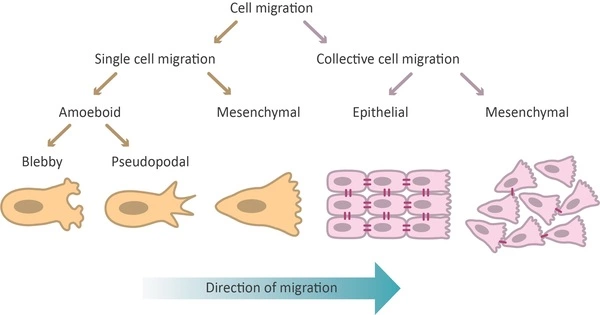Cell migration is a fundamental biological process that involves the movement of cells from one location to another. It is an essential step in the growth and maintenance of multicellular organisms. Tissue formation during embryonic development, wound healing, and immune responses all require coordinated cell movement in specific directions to specific locations. This dynamic phenomenon is critical for many physiological and developmental processes in multicellular organisms.
Cells frequently migrate in response to specific external signals, such as chemical and mechanical signals. Cell migration is essential for tissue repair, embryonic development, immune responses, and tissue homeostasis maintenance. Errors during this process can lead to intellectual disability, vascular disease, tumor formation, and metastasis. Understanding the mechanism by which cells migrate may lead to the development of novel therapeutic strategies for controlling invasive tumor cells, for example.
Because of the highly viscous environment (low Reynolds number), cells must constantly generate forces in order to move. Active movement in cells is accomplished through a variety of mechanisms. Many less complex prokaryotic organisms (including sperm cells) propel themselves using flagella or cilia. Eukaryotic cell migration is typically far more complex and can include a variety of different migration mechanisms.
There are several types of cell migration, which can be divided into two categories: collective cell migration and individual cell migration.
Collective Cell Migration:
- Epithelial Cell Migration: Epithelial cells often migrate collectively during processes such as wound healing and tissue repair. In this type of migration, cell-cell adhesions are maintained, and cells move as cohesive sheets.
- Mesenchymal Cell Migration: This form of migration involves groups of cells that maintain loose connections with each other. Mesenchymal cells migrate individually within a three-dimensional matrix, often seen in processes like embryonic development.
- Neural Crest Cell Migration: During vertebrate development, neural crest cells migrate extensively to different regions of the embryo, giving rise to a variety of cell types.
Individual Cell Migration:
- Amoeboid Movement: This type of movement is distinguished by a rounded cell shape and is frequently observed in immune cells such as macrophages. It consists of cellular protrusions extending, adhering to the substrate, and then contracting the cell body.
- Mesenchymal Migration: Mesenchymal cells, such as fibroblasts, take on a spindle-like shape and migrate by coordinating the extension and retraction of cellular protrusions.
- Chemotaxis: Chemotaxis is the process by which cells migrate in response to chemical gradients. This is frequently important in immune responses, where cells migrate to sites of infection or inflammation.
It usually involves drastic changes in cell shape caused by the cytoskeleton. The most commonly studied migration scenarios are crawling motion and blebbing motility. The case of fish epidermal keratocytes, which have been extensively used in research and education, is a paradigmatic example of crawling motion.
Cell migration is a complex process that involves complex signaling pathways and the coordination of various cellular components such as the cytoskeleton and cell adhesion molecules. Integrins, focal adhesion kinase (FAK), Rho GTPases, and actin filaments are important molecular players in cell migration.
















